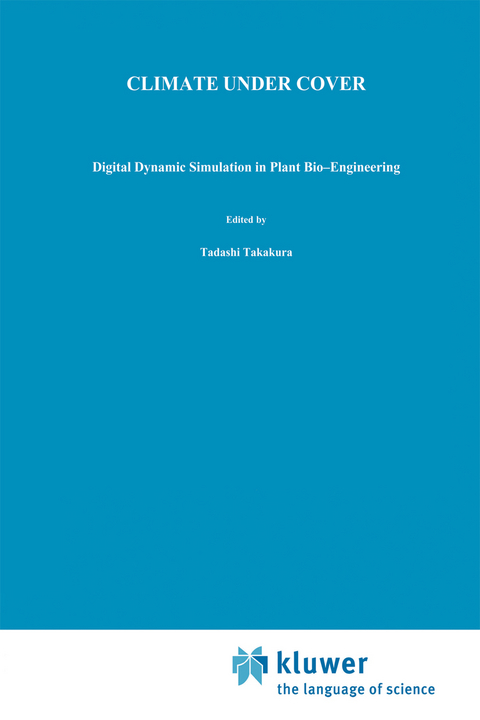
Climate Under Cover
Kluwer Academic Publishers (Verlag)
978-0-7923-2104-0 (ISBN)
From mulching to greenhouses, the air space between the cover and the soil surface is the key to the classification of climates under cover. The same mechanism governs environments produced by the various covers.
This book describes and analyses all the different environments from mulching to greenhouses. The relationship between plants and environment is another important topic in the book.
Stress is placed on the link between quantitative phenomena and qualitative analyses. Most phenomena involved are nonlinear and non-steady-state. An approach called System Dynamics is used, and simulation models developed in the simulation language CSMP are fully used.
The subjects covered are of relevance to graduate students, to scientists and researchers in agriculture and biological sciences and, of course, to agricultural organizations in both the developing and developed countries.
1. Introduction.- 1.1 Introduction.- 1.2 Europe and North America.- 1.3 Asia.- 1.4 Japan.- Problems.- 2. Definition of Covering and Properties of Covering Materials.- 2.1 Introduction.- 2.2 Mulching.- 2.3 Row covers (Tunnels).- 2.4 Floating mulches (Floating row cover).- 2.5 Rain shelters.- 2.6 Unheated greenhouses.- 2.7 Covering materials.- Problems.- 3. Digital Simulation.- 3.1 Introduction.- 3.2 System dynamics.- 3.3 Simulation languages.- 3.4 Digital simulation by CSMP.- 3.5 Model structure and representation.- 3.6 A model for temperature regimes in the soil (CUC-01.- 3.7 Application to steady-state models.- Problems.- 4. Heat Balance of Bare Ground.- 4.1 Introduction.- 4.2 Convective heat transfer.- 4.3 A model with solar radiation and air temperature boundary condition (CUC-02).- 4.4 Mass transfer.- 4.5 A model with latent heat transfer (CUC-03).- 4.6 Radiation balance.- 4.7 Long-wave radiation.- Problems.- 5. Solar Radiation Environment.- 5.1 Introduction.- 5.2 Units of radiation and light.- 5.3 Solar radiation properties of covering materials.- 5.4 Calculation of transmissivity (CUC-04).- 5.5 Solar radiation.- 5.6 The sun’s altitude and azimuth.- Problems.- 6. Temperature Environment under Cover.- 6.1 Introduction.- 6.2 Effect of mulching.- 6.3 Temperature environment under row covers (CUC-30).- 6.4 Double layer greenhouse model (CUC-50).- 6.5 A pad and fan greenhouse model (CUC-35).- Problems.- 7. CO2 Environment.- 7.1 Introduction.- 7.2 CO2 concentration in soil layer (CUC-70).- 7.3 CO2 concentration in a plastic house and ventilation.- Problems.- 8. Water and Water Vapor Environment.- 8.1 Introduction.- 8.2 Water and water vapor movement in soil.- 8.3 Application to water and heat balance in soil layer (CUC-90).- 8.4 Interaction between water movement andheat flow.- Problems.- 9. Control Function.- 9.1 Introduction.- 9.2 System response.- 9.3 PID control.- 9.4 Temperature control logic (CUC-120).- 9.5 Feedback vs. feedforward control.- Problems.- 10. Plant Response to the Environment.- 10.1 Introduction.- 10.2 Plant photosynthesis and respiration.- 10.3 Energy balance of a plant leaf.- 10.4 Stomata resistance of plant (CUC-151).- 10.5 Plant growth model.- Problems.- References.
| Erscheint lt. Verlag | 31.1.1993 |
|---|---|
| Zusatzinfo | XII, 155 p. |
| Sprache | englisch |
| Maße | 155 x 235 mm |
| Themenwelt | Informatik ► Grafik / Design ► Digitale Bildverarbeitung |
| Mathematik / Informatik ► Informatik ► Theorie / Studium | |
| Mathematik / Informatik ► Mathematik | |
| Naturwissenschaften ► Biologie ► Botanik | |
| Naturwissenschaften ► Geowissenschaften ► Geologie | |
| ISBN-10 | 0-7923-2104-9 / 0792321049 |
| ISBN-13 | 978-0-7923-2104-0 / 9780792321040 |
| Zustand | Neuware |
| Informationen gemäß Produktsicherheitsverordnung (GPSR) | |
| Haben Sie eine Frage zum Produkt? |
aus dem Bereich


